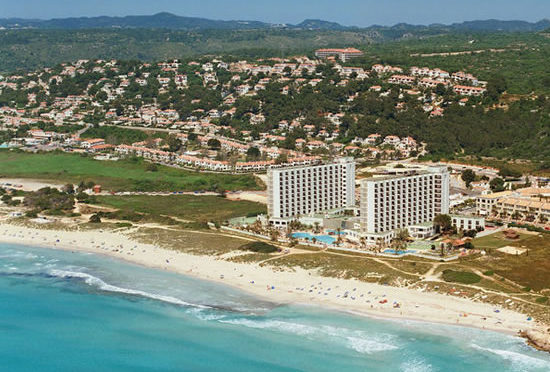Views: 1142
GOB considers that the two towers that rise up on the front line of the Son Bou beach did not comply with any of the building conditions of the licence that was given. If the building is not legal no renovation work can be made nor can the hotel be enlarged.
The Group has sent, recently, a new written communication to the Alaior Local Council pointing out the potential breaches in law they have found. It is in addition to one sent two years ago but to which no one has replied.
As will be remembered, GOB warned in February 2018, having consulted historic records of the hotels, that the licence from the seventies was given with building conditions containing construction parameters of 0,2 m3 per m2 (1 m3 every 5 m2). Given that the project in the seventies referred to a plot of land of 25,000 m2, the resulting building could not be more than 5,000 m3; yet it is 93,000 m3.
In the old records (of the Alaior local Council and of the Government) some documentation is missing. The Government made an investigation in the College of Architects (Architects Association) and found that the project cited the Son Bou finca as having 100 hectares and, that being said, it could be that the hotels were observing the maximum parameters allowed in the licence.
Moreover, the reality of the land registry, where the two towers are built, shows that the property consisted of two plots of land, dated 19 November 1971 (10 days before the licence) of 9.430 m2 each one, without maintaining any registration relationship to the original parent finca. So, there is a double breach of the licence, where no respect is paid to the established parameters of 0.2 m3 per m2 nor any condition for allowing a project on one plot of 25,060 m2.
There are other conditioning factors of the licence which seem not to have been observed and which GOB has included in its written communication to the Alaior Local Council. Specifically, the obligation to purify the sewage water for irrigation, and the prohibition of any type of sewage being drained into the sea.
The sewage water is purified at a purification centre that then discharges it over an area that not only risks contaminating aquifers but where there is no proof of using it for irrigation. The effluent goes along the ravine that ends up in the Llucalari creek, in other words, in the sea. For these reasons, the opinion has been sought from the municipal institution regarding what compliance there is for these conditions.
It should be remembered, also, that a written request has already been made for verification of the obligations required by the Technical Code for Building for the reformation of buildings. This rule asks for foundations to be between 14 to 30 metres deep for buildings such as the Son Bou towers.
Let us remember that the project presented by Melià maintains the current height of those towers facing the sea but foresees a 20% enlargement of the hotel by building between the two towers. The tourist authorisation processed by the Consell Insular (the Menorca Island Government) is contingent on the legality of the building. This building certification is the responsibility of the local town council.
GOB considers the towers at Son Bou are an affront to the Menorca coastline. They were constructed in the seventies when there was no democracy. Perhaps, for that reason, the municipal architect made a report saying that the hotels improved the landscape. Perhaps, also, it is why the municipal technician appears in the document acting as the property manager of the farm.
However, after 50 years, these buildings have amortized having generated a great deal of benefits to the property business owners. Menorca is not interested in offering tourism that makes a huge impact on the landscape, based on sun and beach holidays, with characteristic overcrowding from building such as this, where only the “all included” tourists go.
For these reasons, GOB is tracking the process with the intention of having a project presented that is more appropriate for the 21st Century rather than one from the era that preceded democracy.

